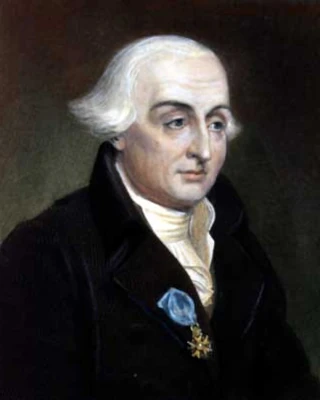
Born Giuseppe Lodovico Lagrangia on January 25, 1736, in Turin (then capital of the Duchy of Savoy), to a family of French and Italian origin, he later adopted the French form of his name. His father, Giuseppe Francesco Lodovico Lagrangia, wanted him to become a lawyer, but the young Joseph-Louis developed a passion for mathematics after reading a work by Edmond Halley (1656-1742) on analysis.
A brilliant autodidact, he became a professor of mathematics at the Royal Artillery School of Turin at just 19 years old. His early work on the calculus of variations (1755) caught the attention of Leonhard Euler (1707-1783), who recommended him to the Berlin Academy.
Lagrange made history with fundamental contributions:
His major work, Analytical Mechanics (1788), is considered a foundational work in mathematical physics. In it, he demonstrates that all of mechanics can be derived from a single principle, the principle of least action, which he formulates as: \( \delta \int_{t_1}^{t_2} T - V \, dt = 0 \) where \( T \) is kinetic energy and \( V \) is potential energy.
Lagrange made decisive contributions to astronomy:
His research on Lagrange points (denoted L1 to L5) is now crucial for space missions. The JWST is positioned at the L2 point of the Earth-Sun system.
| Concept | Lagrange | Newton | Euler |
|---|---|---|---|
| Main Approach | Analytical (equations) | Geometric (forces) | Analytical (functions) |
| Major Work | Analytical Mechanics (1788) | Principia (1687) | Mechanica (1736) |
| Key Contribution | Lagrange Points | Laws of Motion | Fluid Mechanics |
| Mathematical Method | Calculus of Variations | Differential Geometry | Infinitesimal Analysis |
| Sources: Analytical Mechanics (Lagrange, 1788); Philosophiæ Naturalis Principia Mathematica (Newton, 1687); Mechanica (Euler, 1736) | |||
In 1766, Lagrange succeeded Euler at the Berlin Academy on the recommendation of Jean le Rond d'Alembert (1717-1783). He stayed there for 20 years before moving to Paris in 1787, where he became a member of the Academy of Sciences.
Despite the French Revolution, he was spared due to his status as a foreigner and the general esteem for his genius. He even participated in the creation of the metric system and the École Polytechnique in 1794.
Napoleon Bonaparte (1769-1821), who admired his work, appointed him Count of the Empire in 1808 and Senator. Upon his death in 1813, he was buried in the Panthéon, where his eulogy was delivered by Pierre-Simon Laplace.
Lagrange's influence extends to almost all areas of mathematics and physics:
His analytical approach to mechanics inspired:
As Siméon Denis Poisson (1781-1840) said: "Lagrange brought mathematics to a degree of perfection they had not yet attained." His name is now attached to many fundamental concepts, from Lagrange points in astronomy to multipliers in optimization, and the Lagrangian in quantum physics.
In his later years, Lagrange devoted himself to revising his works and teaching at the École Polytechnique. He died in Paris on April 10, 1813, leaving behind an immense scientific legacy.
His tomb in the Panthéon bears this simple yet eloquent epitaph: "To the memory of Joseph-Louis Lagrange, genius geometer and mechanic, born in Turin on January 25, 1736, died in Paris on April 10, 1813."